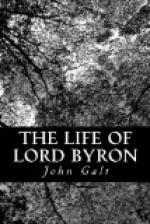Erneis and Ralph were the companions of the Conqueror; but antiquaries and genealogists have not determined in what relation they stood to each other. Erneis, who appears to have been the more considerable personage of the two, held numerous manors in the counties of York and Lincoln. In the Domesday Book, Ralph, the direct ancestor of the poet, ranks high among the tenants of the Crown, in Notts and Derbyshire; in the latter county he resided at Horestan Castle, from which he took his title. One of the lords of Horestan was a hostage for the payment of the ransom of Richard Coeur de Lion; and in the time of Edward I., the possessions of his descendants were augmented by the addition of the Manor of Rochdale, in Lancashire. On what account this new grant was given has not been ascertained; nor is it of importance that it should be.
In the wars of the three Edwards, the de Byrons appeared with some distinction; and they were also of note in the time of Henry V. Sir John Byron joined Henry VII. on his landing at Milford, and fought gallantly at the battle of Bosworth, against Richard III., for which he was afterwards appointed Constable of Nottingham Castle and Warden of Sherwood Forest. At his death, in 1488, he was succeeded by Sir Nicholas, his brother, who, at the marriage of Arthur, Prince of Wales, in 1501, was made one of the Knights of the Bath.
Sir Nicholas died in 1540, leaving an only son, Sir John Byron, whom Henry VIII. made Steward of Manchester and Rochdale, and Lieutenant of the Forest of Sherwood. It was to him that, on the dissolution of the monasteries, the church and priory of Newstead, in the county of Nottingham, together with the manor and rectory of Papelwick, were granted. The abbey from that period became the family seat, and continued so until it was sold by the poet.
Sir John Byron left Newstead and his other possessions to John Byron, whom Collins and other writers have called his fourth, but who was in fact his illegitimate son. He was knighted by Queen Elizabeth in 1579, and his eldest son, Sir Nicholas, served with distinction in the wars of the Netherlands. When the great rebellion broke out against Charles I., he was one of the earliest who armed in his defence. After the battle of Edgehill, where he courageously distinguished himself, he was made Governor of Chester, and gallantly defended that city against the Parliamentary army. Sir John Byron, the brother and heir of Sir Nicholas, was, at the coronation of James I., made a Knight of the Bath. By his marriage with Anne, the eldest daughter of Sir Richard Molyneux, he had eleven sons and a daughter. The eldest served under his uncle in the Netherlands; and in the year 1641 was appointed by King Charles I., Governor of the Tower of London. In this situation he became obnoxious to the refractory spirits in the Parliament, and was in consequence ordered by the Commons to answer at the bar of their House certain charges which the sectaries alleged against him. But he refused to leave his post without the king’s command; and upon’ this the Commons applied to the Lords to join them in a petition to the king to remove him. The Peers rejected the proposition.




